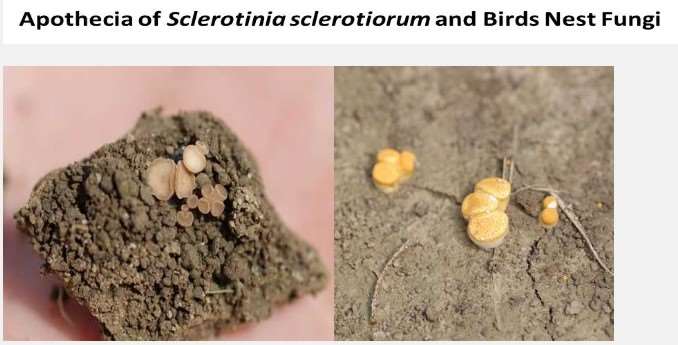By Anne Dorrance
We are approaching (if not already there) the flowering stage of soybean in many parts of Ohio. The cool nights and wet conditions over the last couple of weeks are very favorable for infection of Sclerotinia sclerotiorum, the fungus that causes Sclerotinia stem rot or white mold of soybean. This is particularly concerning if you have a field with history of this disease and if a susceptible cultivar was planted.
The fungus forms sclerotia which are black, hard and irregular bodies with a pink to white center. Sclerotia can survive in the soil for many years, and the cool and wet conditions are favorable for germination and production of apothecia. Note that not every field in Ohio has inoculum. Sclerotia must be introduced into a field with contaminated seed or from another susceptible crop.
Infection is favored by narrow row spacing (7 - 15 in), high plant populations, and canopy closure at or prior to flowering. Apothecia are reproductive structures that look like little mushrooms that are the size of small erasers. Spores released from apothecia land on dead flowers and can infect the plant. Symptoms will not be observed for several weeks (2 to 8 weeks).
If you are scouting fields this week, focus on areas where the canopy is thick and look for small mushrooms structures on the soil surface under the soil canopy. They have a light-tan to brown color. But be careful! Do no mistake the apothecia by birds nest or any other fungi that produces similar structures (Figure 1).

If a susceptible cultivar was planted and the cool nights, rain and heavy dews continue to occur, consider a fungicide application at the beginning of flowering stage (R1) to full flowering (R2). Results from 3 years of field trials have indicated that boscalid (Endura) fungicide is a good option for management of white mold. Also, lactofen herbicide (Phoenix) reduced disease incidence and severity when applied, however, be aware that some burning of the soybean canopy will be observed which will delay canopy closure in a few days. If soybean plants have already had some sort of stress during this growing season, application of lactofen is not recommended since it may also reduce yield. Picoxystrobin (Aproach) fungicide should be applied very early in the beginning of flowering stage (early R1).
If a resistant cultivar was planted, some disease will develop but it will be below the economic threshold. In most cases, incidence of 20% does not result in yield loss as the plants that are healthy next to the disease plants will compensate. Work with your seed supplier to determine if the variety planted in the historic white mold fields has a good resistance score. This is a type of partial resistance where fewer plants will become diseased, and even if infection does occur the disease will develop at a slower rate. If the resistance scores are good – then a fungicide will not be needed under Ohio conditions. In 3 years of studies, we were able to demonstrate that company scores were good and that a fungicide did not reduce the disease to any lower levels that warranted the spray.
Fungicides are only necessary if the field has a history of the disease and a susceptible cultivar is planted. In addition, if the fields are past flowering (late R2), it is too late for a fungicide application for white mold.